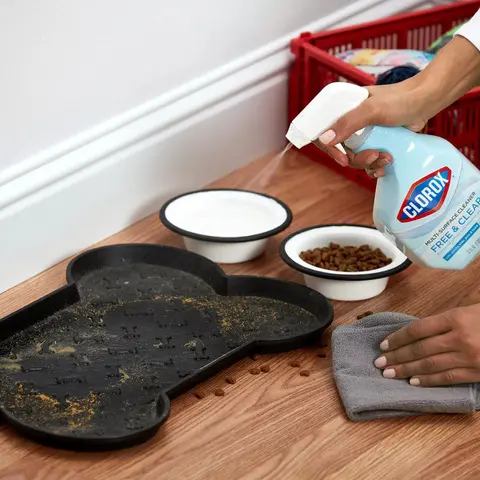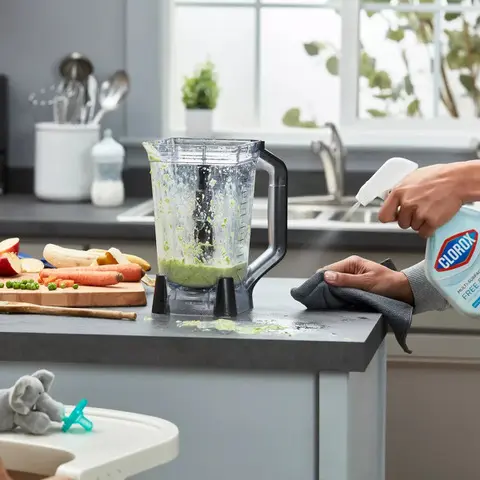When Tackling Cleaning Tasks, Choosing the Level of Cleaning Power Matters.
Your level of cleaning power will determine your results, whether you purchase branded cleaning products, select eco-friendly cleaning agents, or create home-based products (DIY). Let’s explore some options.
1. Cleaning and Disinfecting for different surfaces
Purchasing a standard multipurpose cleaner or disinfectant for general cleaning is an excellent choice for use on various hard surfaces. A formulated versatile product, like Clorox Free & Clear Multi-Surface Cleaner, is a trusted favorite because it effectively cleans multiple surfaces without dyes, ammonia, or bleach. Using plant— and mineral-based ingredients is a valuable helpmate to your cleaning arsenal.
Additionally:
- This product safely removes oils and seasoning residues from kitchen preparation areas, countertops, toys, and soil from floors and appliances. A refreshing, clean look is a phenomenal reset for any room.
- Pictures of Safe Cleaning Scenarios with this product:



Here is the difference between disinfectants and multipurpose cleaners.
- All-purpose cleaners remove dirt and germs
- You’ll want to use a disinfectant to kill bacteria and germs
Understanding this distinction can help you make more informed decisions about which products to use and when. Remembering to check the product label will ensure the cleaner suits your cleaning task.
2. How often should I clean certain areas of my house?
- High-traffic areas such as the kitchen and bathroom should be cleaned at least once weekly.
- Bedrooms and living rooms can be cleaned less frequently, but weekly dusting and vacuuming is a wise recommendation.
For example, home interior spaces with pets require more frequent cleaning. A double-coated furry pet will shed, so furnishings will require more frequent dusting and vacuuming, while a single-coat pet with hair will not shed. This is a distinctive difference.
3. Can I Create (DIY) Cleaners for my Tasks?
Don’t be afraid to experiment with homemade cleaning solutions using household items such as vinegar, baking soda, lemon juice, and essential oils. You might be surprised at how effective they can be.
Numerous DIY recipes for all-purpose cleaners and hard surface cleaners are available online. Adding essential oils to a homemade cleaning solution adds a fresh and pleasant scent that uniquely creates an aromatic fragrance for your home.
DIY Recipe: All-purpose cleaner for kitchen countertops and sinks.
- Equal parts white vinegar and water
- Add around 10 drops of essential oils to offset the vinegar smell; however, this smell should disappear soon after cleaning down surfaces. You can also infuse your vinegar with the rind of lemons or oranges to offset the scent.
Important information: Sealed granite bathroom and kitchen countertops are not candidates for these homemade products. Some DIY cleaning recipes can be effective on granite, but improper use can damage the sealant and cause discoloration.
Further, here are some things to avoid when cleaning granite:
- Acidic cleaners
- Avoid cleaners that contain vinegar, lemon juice, or other acids, as these can etch and discolor the granite.
- Avoid cleaners with ammonia or bleach, which can weaken the sealant over time.
Feel free to clean the granite counters using a few drops of neutral dish liquid soap mixed into water. After cleaning, rinse with plain water and buff the surface dry.
4. Eco-friendly cleaning products are another choice!
From my experience, these products are outstanding for safely cleaning and maintaining surfaces daily or frequently without damaging them. The solutions are gentle and less concentrated than the standard cleaning formulas and are made to clean dirt, disinfect, and kill germs. Using eco-friendly cleaning products helps protect the environment by reducing harsh chemicals and promoting a healthier indoor environment for you and your family.
- Eco-friendly cleaning products are made with natural ingredients labeled as biodegradable, non-toxic, and free of harsh chemicals.
Critical Tips:
- Do not mix cleaning solutions with other cleaning products unless specifically instructed to do so. Mixing cleaning products can be dangerous because it can create chemical reactions that produce toxic substances. These substances can release toxic fumes that can cause irritation or burning of the eyes, nose, and throat, as well as coughing, difficulty breathing, and lung damage. The general rule is not to mix!
- Open the windows during the cleaning process. Ensure sufficient ventilation (airflow) when using cleaning chemicals.
- Wear protective rubber gloves during the cleaning process.
There are four distinct differences when cleaning:
- General wiping to remove dirty matter.
- Dusting high and low surfaces.
- Vacuuming floors and upholstered items.
- Sanitizing & Disinfecting to remove bacteria and viruses from high-touch items and surfaces (bathrooms and kitchen areas, for example).
Knowing these differences, you will view, feel, and smell a clean result.
It is vital to use the right branded products or DIY agents for your cleaning tasks. Using an incorrect cleaner on a surface can damage it. For example, an abrasive cleaner can scratch glass, and using glass cleaner on stainless steel can cause streaks and dull the stainless grain.
I’m here if you have questions: info@askcindyhow.com
Additional cleaning tips: Check out “Cleaning and Disinfecting Kitchen & Bathroom Countertops“.
I promise that “A Clean Home Can Be Yours!” – Let’s clean the house together.
Enjoy the end of summer and stay safe!


